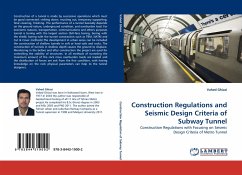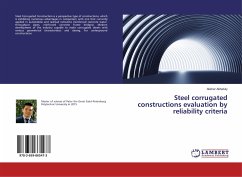
QUANTIFYING SEISMIC DESIGN CRITERIA FOR CONCRETE BUILDINGS
The amount of shear walls necessary to satisfy Earthquake Code requirements
Versandkostenfrei!
Versandfertig in 6-10 Tagen
66,81 €
inkl. MwSt.

PAYBACK Punkte
33 °P sammeln!
The amount of total and relative sway of a framed or a composite (frame-shear wall) building is of utmost importance in assessing the seismic resistance of the building. Therefore, the design engineer must calculate the sway profile of the building several times during the design process. However, it is not a simple task to calculate the sway of a three-dimensional structure. Of course, computer programs can do the job, but developing the three-dimensional model becomes necessary, which is obviously tedious and time consuming.An easy to apply analytical method is developed, which enables the d...
The amount of total and relative sway of a framed or
a composite (frame-shear wall) building is of utmost
importance in assessing the seismic resistance of
the building. Therefore, the design engineer must
calculate the sway profile of the building several
times during the design process.
However, it is not a simple task to calculate the
sway of a three-dimensional structure. Of course,
computer programs can do the job, but developing the
three-dimensional model becomes necessary, which is
obviously tedious and time consuming.
An easy to apply analytical method is developed,
which enables the determination of sway profiles of
framed and composite buildings subject to seismic
loading. This enables the design engineer to
evaluate the sway at any vertical level of the
building, thus enabling the calculation of relative
as well as the maximum sway. By using the proposed
analytical method, the amount of shear walls
necessary to satisfy Earthquake Code requirements
are determined. Thus, a vital design question has
been answered, which up till present time, could
only be met by rough empirical guidelines.
a composite (frame-shear wall) building is of utmost
importance in assessing the seismic resistance of
the building. Therefore, the design engineer must
calculate the sway profile of the building several
times during the design process.
However, it is not a simple task to calculate the
sway of a three-dimensional structure. Of course,
computer programs can do the job, but developing the
three-dimensional model becomes necessary, which is
obviously tedious and time consuming.
An easy to apply analytical method is developed,
which enables the determination of sway profiles of
framed and composite buildings subject to seismic
loading. This enables the design engineer to
evaluate the sway at any vertical level of the
building, thus enabling the calculation of relative
as well as the maximum sway. By using the proposed
analytical method, the amount of shear walls
necessary to satisfy Earthquake Code requirements
are determined. Thus, a vital design question has
been answered, which up till present time, could
only be met by rough empirical guidelines.












